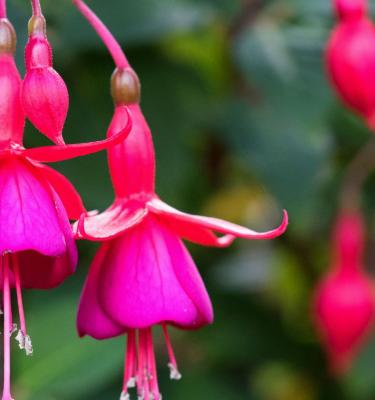

How to grow & care for Fuchsia
Fuchsia plants produce delicate and colourful hanging flowers that look like twirling ballerinas in spring, summer and autumn. Fuchsias grow well in a spot with morning sun or part shade, away from strong winds and with protection from frosts.
Fuchsias prefer a compost rich, moist soil that’s free draining - but they can also be grown successfully in pots. Taller growing fuchsias can be clipped into hedges, medium sized plants look wonderful in garden borders amongst other flowering plants and compact varieties work well in pots or hanging baskets.
Top 5 steps to growing fuchsia
- Choose a spot that receives morning sun or part shade to grow fuchsia, with protection from strong winds and frost
- Mix Scotts Osmocote Compost Premium Soil Improver through the soil before planting.
- Choose a variety or cultivar of fuchsia to suit your growing space - they range in mature size from 30cm tall up to 2 metres tall - the smaller fuchsia are best in pots.
- Fuchsia are frost sensitive - provide them with frost protection over winter if needed
- Fuchsia flower on new growth and can take a hard cut back after flowering to encourage bushy growth and more flowers the following season.
Shopping List
- A fuchsia plant
- Scotts Osmocote Compost Premium Soil Improver
- Scotts Osmocote Controlled Release Fertiliser: All Purpose
- Scotts Osmocote Pour+Feed for Flowering Plants
- Garden Shovel
- If growing in pots, you’ll need Scotts Osmocote Premium Potting Mix + Scotts Osmocote Pour+Feed for Flowering Plants and a suitable pot or container
- Garden Shovel
- Mulch
- Defender Pyrethrum Insect Spray
Preparation
Choose a spot for your fuchsia that receives morning sun or part shade. If you live in a region with frosts, make sure you location is also somewhere protected from frosts. Remember you can choose to grow them in pots if needed.
Fuchsias prefers a moist, yet free draining soil that has been enriched with organic matter. Before planting prepare the soil by mixing Scotts Osmocote Compost Premium Soil Improver and Scotts Osmocote Controlled Release Fertiliser: All Purpose through the top 20-30cm of soil.
Planting in the garden
Plant your fuchsia into prepared soil - dig the hole twice as wide as the original pot and the same depth. Gently remove the fuchsia from the nursery pot and tease the roots lightly if they’re compact.
Plant into the hole and backfill around the plant. Water in well. Mulch around the base of your fuchsia to retain moisture and suppress weeds, but keep the mulch away from the main stem.
Planting in pots
Smaller growing or compact fuchsias can be grown in pots or planters with good drainage, look for a pot that will suit the mature height and width of your chosen fuchsia.
Fill your pot or planter with Scotts Osmocote Premium Potting Mix. Gently remove the fuchsia from the nursery pot and tease the roots lightly if they are compact. Plant the fuchsia into the potting mix and backfill around the plant. Water in well and mulch over the surface of the potting mix to help retain moisture, but keep the mulch back from the plants main stem.
Fertilising & Care
Fuchsias are fairly slow growing and don’t need a lot of fertiliser. However an application of Scotts Osmocote Pour+Feed for Flowering Plants once a fortnight particularly at the start of the flowering season is ideal and at any stage the plant seems to need some extra nutrients.
Reapply a layer of compost and mulch around the plants drip zone each spring to help retain moisture and suppress weeds. If you live in an area without much summer rainfall, your fuchsia will need regular watering during dry times.
Throughout the flowering season deadhead spent flowers. In winter or early spring (if you have frosts) you can give the whole fuchsia plant a hard cut back to encourage a bushy growth habit and more flowers for the coming season.
Pests & Diseases
Fuchsias are generally relatively pest and disease free. Caterpillars and aphids may infest fuchsia plants sometimes - if this happens you can try removing them manually or with a squirt from a hose or spray with an insecticide like Defender Pyrethrum Insect Spray to control them.
Reduce the risk of powdery mildew and other fungal disease outbreaks on your fuchsias leaves by avoiding overhead watering and remove any infected leaves immediately.



